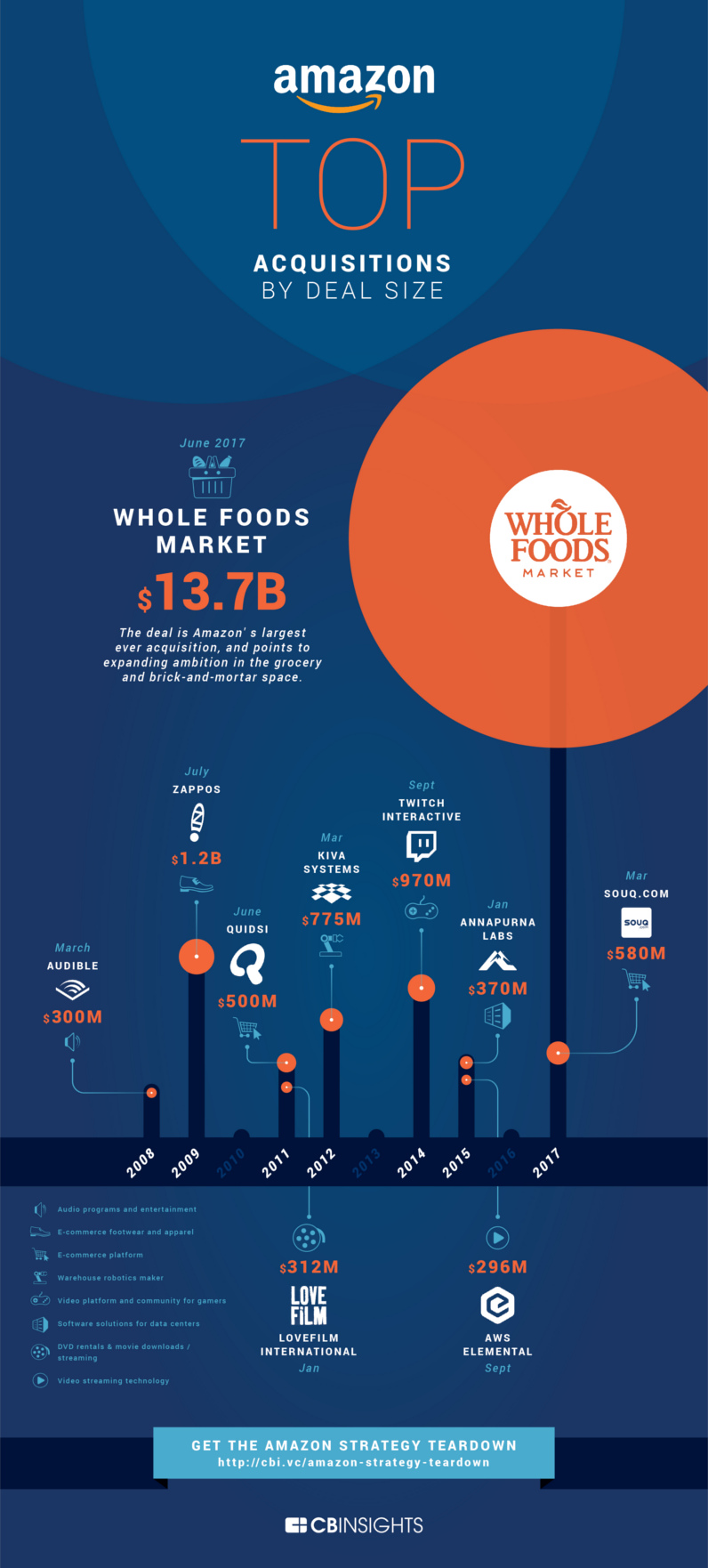Technology
Amazon’s Biggest Acquisitions
Published in 2013, Brad Stone’s book The Everything Store paints an ambitious and relentless portrait of Jeff Bezos, a man who is determined to create an online store that will someday be “everything to everyone”.
As prescient as this characterization was at the time, the narrative is even more relevant now – and with Amazon’s most recent acquisition of Whole Foods Market for $13.7 billion, it’s clear that no market is safe from the sprawling Bezos Empire.
The Everything Store
Today’s infographic comes to us from CB Insights and it shows how Amazon’s strategy is unfolding, as well as which acquisitions are helping in the company’s quest to become the fabled “everything” store.

While buying Zappos ($1.2B), Twitch ($970M), and Kiva Systems ($775M) were all essential to Amazon’s strategy, the price paid for these companies is minuscule in comparison to the massive $13.7 billion acquisition of Whole Foods Market.
Amazon’s Biggest Acquisitions
Here’s how each of these acquisitions is helping to fuel Amazon’s ambitions:
Whole Foods
Amazon’s boldest move yet, buying Whole Foods signals Amazon’s goal of becoming a transcendent brand that touches every aspect of daily life. Most people need to buy groceries every week – and that gives Amazon a new and more frequent window to interact with customers.
Zappos
Known for its obsessive customer service and company culture, Zappos was most likely bought by Amazon for its team.
Kiva Systems
Now re-branded as Amazon Robotics, this company specializes in manufacturing mobile robotic fulfillment systems for Amazon’s array of warehouses.
Elemental Technologies
Amazon’s AWS unit has integrated Elemental’s unique mobile video technology into its cloud infrastructure services.
Lovefilm
Thought as the “Netflix of Europe”, Lovefilm’s streaming services were re-branded as Amazon Prime Instant Video in 2014.
Souq.com
Amazon bought this Dubai-based retailer to improve its footprint in the Middle East – and to prevent global competitors like Alibaba and Flipkart from making inroads in the market.
Quidsi
Bought by Amazon in 2011, Quidsi ran six shopping sites, including Diapers.com, Soap.com and Wag.com. After a brief stint at Amazon, Quidsi founder Marc Lore left to start Jet.com – which was sold to Walmart for $3.3 billion.
Audible
Owning the leader in audiobooks was a no-brainer for Amazon, and the Audible acquisition went down in 2008.
Annapurna Labs
This secretive Israeli semiconductor chip designer was snatched up by Amazon in 2015.
Twitch
Amazon bought Twitch, a video game live streaming company, in 2014 when the service was flush with 55 million subscribers. Today, Twitch.tv is the 40th most visited website worldwide, and is particularly known for its broadcasts of eSports competitions.
Technology
Ranked: Semiconductor Companies by Industry Revenue Share
Nvidia is coming for Intel’s crown. Samsung is losing ground. AI is transforming the space. We break down revenue for semiconductor companies.
Semiconductor Companies by Industry Revenue Share
This was originally posted on our Voronoi app. Download the app for free on Apple or Android and discover incredible data-driven charts from a variety of trusted sources.
Did you know that some computer chips are now retailing for the price of a new BMW?
As computers invade nearly every sphere of life, so too have the chips that power them, raising the revenues of the businesses dedicated to designing them.
But how did various chipmakers measure against each other last year?
We rank the biggest semiconductor companies by their percentage share of the industry’s revenues in 2023, using data from Omdia research.
Which Chip Company Made the Most Money in 2023?
Market leader and industry-defining veteran Intel still holds the crown for the most revenue in the sector, crossing $50 billion in 2023, or 10% of the broader industry’s topline.
All is not well at Intel, however, with the company’s stock price down over 20% year-to-date after it revealed billion-dollar losses in its foundry business.
| Rank | Company | 2023 Revenue | % of Industry Revenue |
|---|---|---|---|
| 1 | Intel | $51B | 9.4% |
| 2 | NVIDIA | $49B | 9.0% |
| 3 | Samsung Electronics | $44B | 8.1% |
| 4 | Qualcomm | $31B | 5.7% |
| 5 | Broadcom | $28B | 5.2% |
| 6 | SK Hynix | $24B | 4.4% |
| 7 | AMD | $22B | 4.1% |
| 8 | Apple | $19B | 3.4% |
| 9 | Infineon Tech | $17B | 3.2% |
| 10 | STMicroelectronics | $17B | 3.2% |
| 11 | Texas Instruments | $17B | 3.1% |
| 12 | Micron Technology | $16B | 2.9% |
| 13 | MediaTek | $14B | 2.6% |
| 14 | NXP | $13B | 2.4% |
| 15 | Analog Devices | $12B | 2.2% |
| 16 | Renesas Electronics Corporation | $11B | 1.9% |
| 17 | Sony Semiconductor Solutions Corporation | $10B | 1.9% |
| 18 | Microchip Technology | $8B | 1.5% |
| 19 | Onsemi | $8B | 1.4% |
| 20 | KIOXIA Corporation | $7B | 1.3% |
| N/A | Others | $126B | 23.2% |
| N/A | Total | $545B | 100% |
Note: Figures are rounded. Totals and percentages may not sum to 100.
Meanwhile, Nvidia is very close to overtaking Intel, after declaring $49 billion of topline revenue for 2023. This is more than double its 2022 revenue ($21 billion), increasing its share of industry revenues to 9%.
Nvidia’s meteoric rise has gotten a huge thumbs-up from investors. It became a trillion dollar stock last year, and broke the single-day gain record for market capitalization this year.
Other chipmakers haven’t been as successful. Out of the top 20 semiconductor companies by revenue, 12 did not match their 2022 revenues, including big names like Intel, Samsung, and AMD.
The Many Different Types of Chipmakers
All of these companies may belong to the same industry, but they don’t focus on the same niche.
According to Investopedia, there are four major types of chips, depending on their functionality: microprocessors, memory chips, standard chips, and complex systems on a chip.
Nvidia’s core business was once GPUs for computers (graphics processing units), but in recent years this has drastically shifted towards microprocessors for analytics and AI.
These specialized chips seem to be where the majority of growth is occurring within the sector. For example, companies that are largely in the memory segment—Samsung, SK Hynix, and Micron Technology—saw peak revenues in the mid-2010s.
-

 Real Estate2 weeks ago
Real Estate2 weeks agoVisualizing America’s Shortage of Affordable Homes
-

 Technology1 week ago
Technology1 week agoRanked: Semiconductor Companies by Industry Revenue Share
-

 Money1 week ago
Money1 week agoWhich States Have the Highest Minimum Wage in America?
-

 Real Estate1 week ago
Real Estate1 week agoRanked: The Most Valuable Housing Markets in America
-

 Business1 week ago
Business1 week agoCharted: Big Four Market Share by S&P 500 Audits
-

 AI2 weeks ago
AI2 weeks agoThe Stock Performance of U.S. Chipmakers So Far in 2024
-

 Misc2 weeks ago
Misc2 weeks agoAlmost Every EV Stock is Down After Q1 2024
-

 Money2 weeks ago
Money2 weeks agoWhere Does One U.S. Tax Dollar Go?














